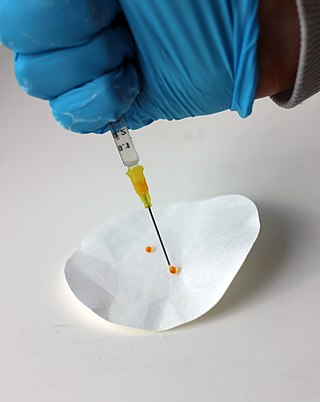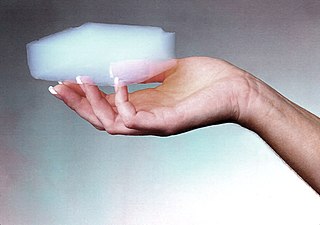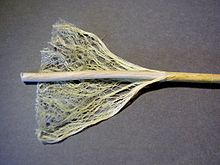
Mineral wool is any fibrous material formed by spinning or drawing molten mineral or rock materials such as slag and ceramics.

Kenaf [etymology: Persian], Hibiscus cannabinus, is a plant in the family Malvaceae also called Deccan hemp and Java jute. Hibiscus cannabinus is in the genus Hibiscus and is native to Africa, though its exact origin is unknown. The name also applies to the fibre obtained from this plant. Kenaf is one of the allied fibres of jute and shows similar characteristics.

Fiber crops are field crops grown for their fibers, which are traditionally used to make paper, cloth, or rope.

Hemp, or industrial hemp, is a botanical class of Cannabis sativa cultivars grown specifically for industrial use. It can be used to make a wide range of products. Along with bamboo, hemp is among the fastest growing plants on Earth. It was also one of the first plants to be spun into usable fiber 50,000 years ago. It can be refined into a variety of commercial items, including paper, rope, textiles, clothing, biodegradable plastics, paint, insulation, biofuel, food, and animal feed.

In the textile industry, a tow is a coarse, broken fibre, removed during processing flax, hemp, or jute and separated from the shives. Flax tows are often used as upholstery stuffing and oakum. Tows in general are frequently cut up to produce staple fibre. The very light color of flax tow is the source of the word "towhead", meaning a person with naturally light blond hair.

Natural fibers or natural fibres are fibers that are produced by geological processes, or from the bodies of plants or animals. They can be used as a component of composite materials, where the orientation of fibers impacts the properties. Natural fibers can also be matted into sheets to make paper or felt.

Bast fibre is plant fibre collected from the phloem or bast surrounding the stem of certain dicotyledonous plants. It supports the conductive cells of the phloem and provides strength to the stem. Some of the economically important bast fibres are obtained from herbs cultivated in agriculture, as for instance flax, hemp, or ramie, but bast fibres from wild plants, as stinging nettle, and trees such as lime or linden, willow, oak, wisteria, and mulberry have also been used in the past. Bast fibres are classified as soft fibres, and are flexible. Fibres from monocotyledonous plants, called "leaf fiber", are classified as hard fibres and are stiff.
Nanotechnology is impacting the field of consumer goods, several products that incorporate nanomaterials are already in a variety of items; many of which people do not even realize contain nanoparticles, products with novel functions ranging from easy-to-clean to scratch-resistant. Examples of that car bumpers are made lighter, clothing is more stain repellant, sunscreen is more radiation resistant, synthetic bones are stronger, cell phone screens are lighter weight, glass packaging for drinks leads to a longer shelf-life, and balls for various sports are made more durable. Using nanotech, in the mid-term modern textiles will become "smart", through embedded "wearable electronics", such novel products have also a promising potential especially in the field of cosmetics, and has numerous potential applications in heavy industry. Nanotechnology is predicted to be a main driver of technology and business in this century and holds the promise of higher performance materials, intelligent systems and new production methods with significant impact for all aspects of society.

A biocomposite is a composite material formed by a matrix (resin) and a reinforcement of natural fibers. Environmental concern and cost of synthetic fibres have led the foundation of using natural fibre as reinforcement in polymeric composites. The matrix phase is formed by polymers derived from renewable and nonrenewable resources. The matrix is important to protect the fibers from environmental degradation and mechanical damage, to hold the fibers together and to transfer the loads on it. In addition, biofibers are the principal components of biocomposites, which are derived from biological origins, for example fibers from crops, recycled wood, waste paper, crop processing byproducts or regenerated cellulose fiber (viscose/rayon). The interest in biocomposites is rapidly growing in terms of industrial applications and fundamental research, due to its great benefits. Biocomposites can be used alone, or as a complement to standard materials, such as carbon fiber. Advocates of biocomposites state that use of these materials improve health and safety in their production, are lighter in weight, have a visual appeal similar to that of wood, and are environmentally superior.
The United Nations General Assembly declared 2009 as the International Year of Natural Fibres (IYNF), as well as the International Year of Astronomy.

Water-repellent glass (WRG) is a transparent coating film fabricated onto glass, enabling the glass to exhibit hydrophobicity and durability. WRGs are often manufactured out of materials including derivatives from per- and polyfluoroalkyl substances (PFAS), tetraethylorthosilicate (TEOS), polydimethylsilicone (PDMS), and fluorocarbons. In order to prepare WRGs, sol-gel processes involving dual-layer enrichments of large size glasses are commonly implemented.

Zirconium diboride (ZrB2) is a highly covalent refractory ceramic material with a hexagonal crystal structure. ZrB2 is an ultra-high temperature ceramic (UHTC) with a melting point of 3246 °C. This along with its relatively low density of ~6.09 g/cm3 (measured density may be higher due to hafnium impurities) and good high temperature strength makes it a candidate for high temperature aerospace applications such as hypersonic flight or rocket propulsion systems. It is an unusual ceramic, having relatively high thermal and electrical conductivities, properties it shares with isostructural titanium diboride and hafnium diboride.

Cellulose fibers are fibers made with ethers or esters of cellulose, which can be obtained from the bark, wood or leaves of plants, or from other plant-based material. In addition to cellulose, the fibers may also contain hemicellulose and lignin, with different percentages of these components altering the mechanical properties of the fibers.

Scutching is a step in the processing of cotton or the dressing of flax or hemp in preparation for spinning. The scutching process separates the impurities from the raw material, such as the seeds from raw cotton or the straw and woody stem from flax fibers. Scutching can be done by hand or by a machine known as a scutcher. Hand scutching of flax is done with a wooden scutching knife and a small iron scraper. The end products of scutching flax are the long finer flax fibers called line, short coarser fibers called tow, and waste woody matter called shives.

Setralit is a technical natural fiber based on plant fibers whose property profile has been modified selectively in order to meet different industrial requirements. It was first manufactured in 1989 by Jean-Léon Spehner, an Alsatian engineer, and further developed by the German company ECCO Gleittechnik GmbH. The name “Setralit“ is derived from the French company Setral S.à.r.l. which is a subsidiary company of ECCO, where Spehner was employed at that time. Setralit was officially described first in 1990.

A superhydrophobic coating is a thin surface layer that repels water. It is made from superhydrophobic (ultrahydrophobicity) materials. Droplets hitting this kind of coating can fully rebound. Generally speaking, superhydrophobic coatings are made from composite materials where one component provides the roughness and the other provides low surface energy.

Aerogels are a class of synthetic porous ultralight material derived from a gel, in which the liquid component for the gel has been replaced with a gas, without significant collapse of the gel structure. The result is a solid with extremely low density and extremely low thermal conductivity. Aerogels can be made from a variety of chemical compounds. Silica aerogels feel like fragile styrofoam to the touch, while some polymer-based aerogels feel like rigid foams.
Ultra-high temperature ceramic matrix composites (UHTCMC) are a class of refractory ceramic matrix composites (CMCs) with melting points significantly higher than that of typical CMCs. Among other applications, they are the subject of extensive research in the aerospace engineering field for their ability to withstand extreme heat for extended periods of time, a crucial property in applications such as thermal protection systems (TPS) and rocket nozzles. Carbon fiber-reinforced carbon (C/C) maintains its structural integrity up to 2000 °C; however, C/C is mainly used as an ablative material, designed to purposefully erode under extreme temperatures in order to dissipate energy. Carbon fiber reinforced silicon carbide matrix composites (C/SiC) and Silicon carbide fiber reinforced silicon carbide matrix composites (SiC/SiC) are considered reusable materials because silicon carbide is a hard material with a low erosion and it forms a silica glass layer during oxidation which prevents further oxidation of inner material. However, above a certain temperature starts the active oxidation of silicon carbide matrix to gaseous silicon monoxide, consequently loss of protection from further oxidation, which leads the material to an uncontrolled and fast erosion. For this reason C/SiC and SiC/SiC are used in the range of temperature between 1200° - 1400 °C.
Hemp paper is paper varieties consisting exclusively or to a large extent from pulp obtained from fibers of industrial hemp. The products are mainly specialty papers such as cigarette paper, banknotes and technical filter papers. Compared to wood pulp, hemp pulp offers a four to five times longer fibre, a significantly lower lignin fraction as well as a higher tear resistance and tensile strength. Because the paper industry's processes have been optimized for wood as the feedstock, production costs currently are much higher than for paper from wood.

Hemp has been grown continuously in France for hundreds of years or longer for use as a textile, paper, animal bedding, and for nautical applications.



















